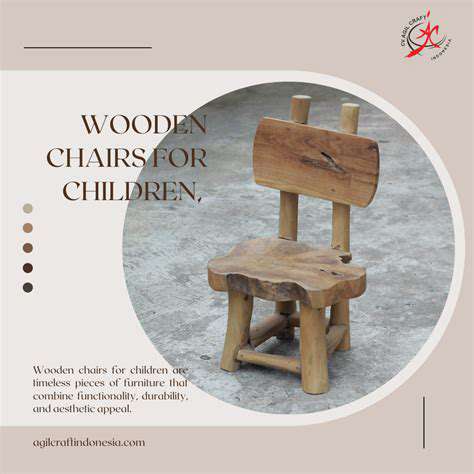How to decorate with wooden furniture in small spaces
Choosing the Right Wooden Furniture for Small Rooms

Understanding Your Needs
When furnishing compact spaces, the first step is evaluating how you'll use the area. Assessing your lifestyle requirements helps identify essential furniture pieces versus nice-to-have items. Smart space planning transforms cramped quarters into functional, inviting areas. For studio apartments, consider convertible pieces like sofa beds or nesting tables that serve multiple purposes.
Traffic flow significantly impacts furniture selection. Measure walking paths and door swings to ensure comfortable movement. This practical approach prevents overcrowding and maintains accessibility in tight spaces.
Material Matters
Wood selection affects both aesthetics and longevity. Hardwoods like oak withstand daily use better than softer woods, making them ideal for small spaces where furniture serves multiple functions. Lighter wood tones visually expand rooms, while darker finishes create cozy atmospheres.
Consider wood grain patterns when selecting pieces. Subtle grains work well in minimalist designs, while pronounced grains add character to rustic styles. The finish - matte, glossy, or distressed - also impacts the room's overall feel.
Consider the Style
Scale and proportion become critical in limited square footage. Furniture with exposed legs creates airiness, while low-profile pieces maintain sightlines, making rooms appear larger. Avoid bulky, overstuffed items that dominate small spaces.
Mix wood tones carefully. Complementary finishes create depth, while matching everything can feel monotonous. Introduce texture through woven elements or metallic accents to add visual interest without clutter.
Budgeting for Your Purchase
Invest in quality foundational pieces first. A well-made wooden bed frame or dining table lasts decades, while trendy accent pieces can be replaced more frequently. Look for solid wood construction rather than veneers for long-term value.
Consider secondhand markets for unique finds. Many vintage wooden pieces feature superior craftsmanship at lower prices than new items. Inspect joints and finishes carefully when buying pre-owned furniture.
Measurements and Space Planning
Create detailed floor plans before shopping. Use painter's tape to mark furniture footprints on floors - this visual trick prevents purchasing items that overwhelm the space. Remember to account for necessary clearances around doors and appliances.
Vertical space often goes underutilized. Tall, narrow bookcases or wall-mounted shelves provide storage without consuming precious floor area. Measure ceiling heights to ensure proper clearance for vertical pieces.
Durability and Maintenance
High-use areas demand resilient materials. Choose woods with natural resistance to scratches and dents, like teak or walnut, for furniture that will see heavy daily use. Consider protective treatments for vulnerable surfaces.
Understand maintenance requirements before purchasing. Some woods need regular oiling, while others require minimal upkeep. Match the care level to your lifestyle and available time for furniture maintenance.
Reviews and Recommendations
Seek out long-term user experiences. Look for reviews discussing how pieces hold up after several years of use, not just initial impressions. Visit showrooms to test furniture in person when possible, especially for critical items like chairs or beds.
Consult interior designers specializing in small spaces. Many offer affordable virtual consultations that can prevent costly furniture mistakes. Their expertise helps maximize every square foot.
Accessorizing for Visual Appeal and Functionality
Choosing the Right Accessories
Strategic accessorizing amplifies both form and function in compact living areas. Select items that serve dual purposes, like ottomans with storage or decorative trays that corral small items. Keep surfaces clutter-free by limiting accessories to a few meaningful pieces.
Textiles for Warmth and Texture
Layer textiles thoughtfully to avoid visual chaos. A single patterned throw pillow can provide enough contrast against neutral wood tones. Sheer curtains maintain light flow while adding softness to wood-framed windows.
Mirrors for Visual Enhancement
Position mirrors to reflect natural light sources. A leaning floor mirror behind a wooden console table doubles perceived depth. Consider mirror placement carefully to avoid creating awkward sightlines in small rooms.
Lighting for Ambiance and Functionality
Combine lighting types for layered illumination. Wall sconces save surface space while providing ambient light. Adjustable task lighting ensures proper illumination for reading or working at wooden desks or tables.
Plants for Life and Vibrancy
Select low-maintenance plants that thrive indoors. Snake plants or pothos vines add greenery without demanding constant care. Use wall-mounted planters or hanging baskets to keep surfaces clear.
Artwork for Personal Expression
Create gallery walls with uniform frames for cohesion. Group smaller pieces together rather than scattering them throughout the room. This approach makes a stronger visual statement without overwhelming limited wall space.
Decorative Bowls and Trays for Organization and Style
Use trays to define functional zones on multi-purpose surfaces. A wooden tray can transform a coffee table into an occasional dining area. Choose containers with lids to discreetly store small items while maintaining a tidy appearance.
- Enhancing Your Space with the Natural Appeal of Wooden Pieces
- Best wooden storage cabinets for organizing your home
- How to remove water stains from wooden furniture surfaces
- The best wood types for furniture that lasts
- How to pair wooden furniture with neutral colors for a calm vibe
- How to use wood furniture to create a warm and inviting atmosphere
- Top benefits of buying locally made wooden furniture
- How to make a statement with large wooden furniture pieces
- How to incorporate wooden furniture into minimalist designs
- How to choose the best wood for your custom furniture design
- How to choose wooden furniture for a modern farmhouse style
- How to choose wooden furniture for your home’s theme